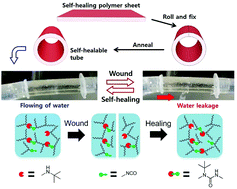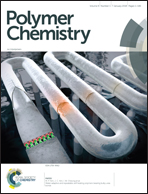Water-adaptive and repeatable self-healing polymers bearing bulky urea bonds†
Abstract
Self-healing polymers bearing reversible and bulky urea bonds were prepared by free-radical copolymerization followed by crosslinking with diisocyanates. Linear prepolymers (PtB) were first synthesized from 2-(tert-butylamino)ethyl methacrylate (tBAEMA), methyl methacrylate (MMA), and n-butyl acrylate (BA), in a molar ratio of 1 : 10 : 10, and then crosslinked with 1,6-diisocyanatohexane (HDI) or isophorone diisocyanate (IPDI) to fabricate self-healing polymers. The reversible bonding–debonding between the tBAEMA of the polymer backbone and the isocyanate units of the crosslinker in the self-healing polymer facilitates rapid, repeatable, and water-adaptive self-healing performance, which has been extensively investigated using 1H-NMR, DSC, FT-IR, AFM, optical microscopy, and rheometric analyses. Percentage recovery (%R) and self-healing efficiency (%SHE) were also studied using tensile and single-scratch tests, respectively, and compared with a control sample. It was revealed through extensive analyses that self-healing against a single scratch can be accelerated and repeated up to a certain number of times even in water, although the self-healing polymers are not water-resistant. We also demonstrated that a self-healable tube capable of containing flowing water could be fabricated from a self-healing polymer sheet by using reversible bonding–debonding characteristics of a reversible bulky urea bond.

- This article is part of the themed collection: Most Downloaded 2018 Articles


 Please wait while we load your content...
Please wait while we load your content...